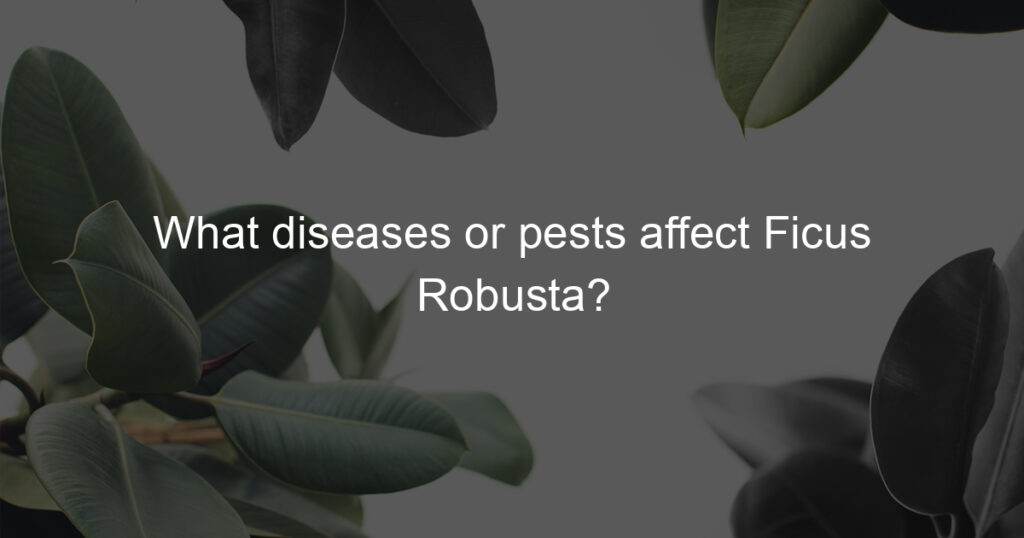For all you ficus tree lovers out there, did you know that there are some common diseases that these trees can get? In this blog post, we’ll take a look at some of the most common ones and how you can prevent them. Keep reading to learn more!
How do I know if my ficus has a fungus?
If you suspect that your focus might have a fungal infection, it is important to know how to identify the signs. Firstly, you will want to look out for any discoloration or yellowing of the leaves.
Additionally, you may find blisters and distortions on the surface of the plant’s leaves. Furthermore, fungal infections often cause branches and stem dieback and rapid leaf drop.
Lastly, if there is mold-like growth growing near the base of the plant, then it is likely due to fungus. Identifying these signs early can help you take steps to address them before irreversible damage is done to your beloved ficus tree.
What is the best fungicide for Ficus?
Ficus plants are popular among home gardeners for their lush, external foliage. Unfortunately, like any other plant, Ficus can be affected by fungi and so it’s important to choose the right fungicide in order to keep your plants healthy.
The best fungicide for Ficus is a combination of prevention and intervention methods. To prevent fungal diseases, it’s important to keep your plants in an area with proper air circulation and adequate sunlight while regularly removing any dead or diseased leaves that could spread the pathogens.
Additionally, spraying the plants with a combination of copper-based fungicide and compost tea on a regular basis can act as an intervention method for any infecting fungi. Doing this along with providing appropriate growing conditions will help ensure that your Ficus stays healthy and beautiful for years to come!
How do I keep my ficus tree healthy?
Keeping your ficus tree healthy requires regular maintenance, from providing enough light to making sure it’s getting the correct amount of water. Many people think that trees don’t need much attention, but just like other plants, they do require attention in order to thrive.
To start, choose a spot for the ficus tree with plenty of natural light and avoid direct sunlight; also, make sure you keep it away from cold drafts. It’s best to water when the soil is dry by giving your tree a thorough dousing with lukewarm water until you notice it draining out of the pot’s bottom drainage holes.
You can add an all-purpose fertilizer every few months if your soil starts to look weak or if new growth stops appearing. With these simple tips, your ficus tree will be on its way to being a stunning centerpiece in no time!
How can you tell if a plant is a fungal or bacterial infection?
Identifying whether a plant has a fungal or bacterial infection can be tricky. An initial clue is a symptom exhibited by the plant—fungal infections generally tend to cause more visible external damage, such as spots and discoloration, whereas bacteria typically causes wilting and yellowing of the leaves.
To make a definitive diagnosis, however, lab analysis may be required. Looking at a sample under a microscope can help differentiate fungal from bacterial since fungi colonies have a fuzzy appearance compared to the pint-sized rods associated with bacteria.
For home gardeners, using fungicides specifically designed for that type of fungus or consulting local experts if unsure of symptoms and treatment can be beneficial for proper plant care.
Why is my ficus turning brown and dropping leaves?
If your ficus is turning brown and dropping leaves, it may be a sign of distress indicating that it isn’t receiving the proper care it needs to thrive. A number of things might be causing the issue, such as lack of light, too much water, or improper fertilizer.
When addressing the problem, start with assessing the plant’s need for light; if possible, shift the plant to a spot that gets sunlight for at least part of the day. For watering and feeding requirements, refer to the label on your plant or do research online to find specific instructions based on your particular type of ficus. Hopefully, with some dedicated TLC, you can get your ficus back into healthy shape!
How do I know if my ficus has root rot?
Knowing whether your ficus has root rot can seem like a daunting task, but it’s important to identify it early in order to save your beloved plant. The first sign of root rot is wilting leaves, though this can be caused by many factors, not just disease.
To be sure you have an infection, check around the base of the plant for discolored patches of soil and look on any exposed roots for same-colored lesions. If found, you’ll need to apply an antibiotic or fungicide to clear the infection.
Other non-chemical treatments such as potting mix changes and watering schedules may also help prevent long-term harm to your ficus. Paying attention and being vigilant are key when trying to keep your plants healthy and happy!
It’s A Wrap
All in all, Ficus plants are a favored choice among indoor plant owners due to their long-lasting characteristics and low-maintenance requirements. However, diseases in Ficus plants can cause reduced vigor and growth, yellowing and dropping of leaves, or premature death if left untreated.
Fortunately, most Ficus plant diseases can be prevented with proactive monitoring, climate control, regular cleaning of leaves and stems, and inspection of pests regularly. Taking the suggested preventative measures will help ensure your Ficus stays happy and healthy in the future.
If you see any signs of disease in your Ficus plant or have questions about how to give it proper care, consult a qualified professional to make sure the issue is addressed promptly. With the proper knowledge and dedication to taking good care of your Ficus friend, you are sure to have an enjoyable experience growing it for years to come!








